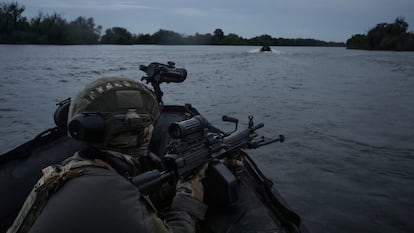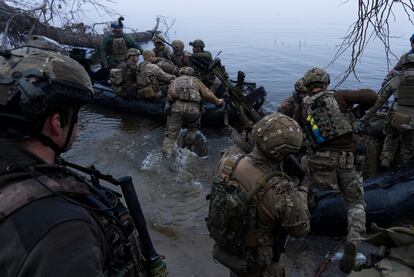Ukraine has advanced across the Dnipro River, its biggest achievement on the front in 12 months
Ukrainian marines and special forces have established several landing points along 12 miles of shore under Russian control


Ukrainian marines and special forces have managed to overcome what the Prussian military genius Carl von Clausewitz wrote in 1832 was nature’s best ally for a defending army: they have been able to advance against an enemy entrenched on the opposite bank of the Dnipro River. Despite all the adversities, several thousand of Ukraine’s crack troops have managed to establish a foothold along 12 miles of the river’s eastern bank, in the Russian-held part of Kherson province, on the war’s southern front.
The Ukrainian Armed Forces have opened a new flank against the invader where it seemed most difficult to achieve. It is their greatest success on the front in the year since the liberation of the western half of Kherson province, on the right bank of the Dnipro. Kyiv’s other significant success since the summer has come from air and marine drone strikes against the Russian fleet in Crimea, driving back enemy warships in the Black Sea. But on land, Ukraine has not had very much good news. The counteroffensive that began in the summer in Zaporizhzhia province did not bring the desired results, and Russia is attacking in the provinces of Donetsk and Kharkiv. Its forces have numerical superiority in terms of artillery, drones, and troops, but this superiority has been at the cost of leaving the southern flank, including Kherson, more vulnerable. The Russian defense relies on the difficulty of overcoming the Dnipro river and its miles of wetlands.
In October, and with the utmost secrecy, the Ukrainian Armed Forces began a campaign of constant assault using speedboats to gain a foothold on the other side of the Dnipro. Although several assaults also occurred in the summer, the large-scale operation was not carried out earlier because miles of fields were flooded when the Kakhovka dam was destroyed last June. The floodwater eventually receded and as the weeks passed, the fields dried out. The result is that the troops have managed to establish what in military theory is known as two “bridgeheads” — two points secured by troops with boats arriving daily, to relieve soldiers and even transport armored light infantry vehicles — as reported to EL PAÍS by Vitali, the commander of a special forces company, who requested that his last name not be published.
The two bridgeheads are about 12 miles apart; one is located near the city of Kherson, in the vicinity of the Antonivskiy bridge, with fighting going on in the town of Oleshky. The other is farther north, in the town of Krinki. To the south of the city of Kherson, the same strategy is also being deployed, according to the weekly military analysis reported on November 15 by Espreso, one of Ukraine’s leading media outlets. Landings have intensified in Hola Pristan, a settlement located four miles from the provincial capital.
In the online publication Oboz on November 15, Roman Svitan, a retired Ukrainian Armed Forces colonel and one of the most cited analysts of the war, maintained that this third spearhead could be decisive in liberating the mouth of the Dnipro, as far as Cape Kinburn. This would force Russian troops to retreat towards Skadovsk, on the border with Crimea, to avoid being cut off. The situation would also allow Ukraine to regain control of the Dniprovska Gulf, a safe river outlet to the Black Sea from Kherson and Mykolaiv.
The Ukrainian General Staff reports that officially the immediate objective is to drive the invader back 12 miles away from the river, to ensure civil and economic life in the municipalities on the left bank can recover. This distance is the minimum to reduce Russia’s ability to use its old Soviet-era artillery to cause destruction in the settlements along the river. Both Espreso and the Institute for the Study of War, an American center analyzing the conflict, emphasize that one of the reasons for the operations in the Dnipro is to force a transfer of Russian troops from the Donetsk, Kharkiv, and Zaporizhzhia fronts to the south. Sources from the High Command for the South assure this newspaper that a land advance from the Dnipro towards Crimea, about 62 miles away, is currently impossible, due to numerically inferior human resources and artillery.
If the two armies agree on something, it is restricting media access to the Dnipro. The Ukrainian High Command for the South has denied the media access and any opportunity to interview soldiers in the rear. In the summer counteroffensive on the Zaporizhzhia front, the Ukrainian military was obsessive about maintaining secrecy. Government representatives publicly complained that the media and analysts were increasingly turning to Russian military sources to understand what was happening on the battlefield. The same thing is happening in Kherson. This November, the BBC interviewed Russian soldiers who fought in Krinki. They claimed that members of the Ukrainian special forces had assaulted their positions wearing uniforms of Russian firefighters or emergency services personnel, which is something that contravenes the Geneva Convention.
These Russian soldiers estimated that 500 Ukrainian soldiers had already landed in Krinki, although the number in the entire area is much higher, as Western military sources told The Guardian on November 16. According to the British newspaper, the Ukrainian Armed Forces had managed to land three marine brigades on the eastern side of Kherson, which would be equivalent to 6,000 soldiers. Taking into account that these troops fight in rotations of several days, it would indicate that there are at least 3,000 soldiers operating on the left bank.
The Russian soldiers also confirmed to the BBC something that Western and Russian analysts have highlighted. The first wave involves the special forces that take enemy positions and then the marine corps comes into action. Clashes between both armies have been reported four kilometers from the shore, but Vitali, the special forces’ commander, remarks that his men have penetrated much further into the enemy’s ranks. The objective is to locate the Russian artillery and drone pilots so that the Ukrainian howitzers and unmanned devices can neutralize them. He says this is key to ensuring river barges can safely transport armored infantry vehicles, such as the American Bradley tanks, in maneuvers that can take up to 40 minutes.

At the moment the infantry has not crossed the river with mechanized brigades, “but very soon it will be possible,” says Vitali. Retired colonel Svitan was not so optimistic in his interview with Oboz, and explained that first of all, assault companies that can manage to keep the Russians nine miles away are needed in addition to the current troops. That will be when pontoon bridges can be put in place and batteries of anti-aircraft defense can be set up on the western bank. For the moment, Svitan commented, the Ukrainians have to act in small tactical groups that are constantly on the move. This is especially important now that the Russian command has assigned a new parachute regiment to regain control in Krinki, as reported on Thursday by Ukrainian military studies institute, the Center for Defense Strategies. “The terrain [wetlands and sandbars] is not suitable for digging trenches, so the best defense is to stay on the move and disperse,” Svitan concluded.
From the rear in Kherson, the Ukrainians are constantly firing howitzers and medium-range precision rockets such as the American Himars, to disrupt the enemy’s logistical lines. The British Ministry of Defense confirmed this Friday that a Ukrainian attack on November 10 destroyed a Russian convoy on the Kherson front, 14 miles from the river, killing more than 70 soldiers. British intelligence services also claim that in Donetsk on November 19, a concentration of Russian troops was bombed, resulting in “dozens of casualties.”
Sign up for our weekly newsletter to get more English-language news coverage from EL PAÍS USA Edition
Tu suscripción se está usando en otro dispositivo
¿Quieres añadir otro usuario a tu suscripción?
Si continúas leyendo en este dispositivo, no se podrá leer en el otro.
FlechaTu suscripción se está usando en otro dispositivo y solo puedes acceder a EL PAÍS desde un dispositivo a la vez.
Si quieres compartir tu cuenta, cambia tu suscripción a la modalidad Premium, así podrás añadir otro usuario. Cada uno accederá con su propia cuenta de email, lo que os permitirá personalizar vuestra experiencia en EL PAÍS.
¿Tienes una suscripción de empresa? Accede aquí para contratar más cuentas.
En el caso de no saber quién está usando tu cuenta, te recomendamos cambiar tu contraseña aquí.
Si decides continuar compartiendo tu cuenta, este mensaje se mostrará en tu dispositivo y en el de la otra persona que está usando tu cuenta de forma indefinida, afectando a tu experiencia de lectura. Puedes consultar aquí los términos y condiciones de la suscripción digital.
More information
Archived In
Últimas noticias
Most viewed
- David King, chemist: ‘There are scientists studying how to cool the planet; nobody should stop these experiments from happening’
- Mexico completes its trade shift with the entry into force of tariffs on China and countries without trade agreements
- Reinhard Genzel, Nobel laureate in physics: ‘One-minute videos will never give you the truth’
- Oona Chaplin: ‘I told James Cameron that I was living in a treehouse and starting a permaculture project with a friend’
- Sinaloa Cartel war is taking its toll on Los Chapitos










































